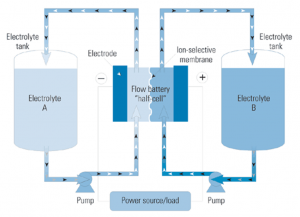Difference between revisions of "Flow Batteries"
Jump to navigation
Jump to search
storagewiki.epri.com>Jthompson |
|||
| (One intermediate revision by the same user not shown) | |||
| Line 4: | Line 4: | ||
{{#set: | {{#set: | ||
Has How it Works Description=Liquid anode (anolyte) and cathode (catholyte) | Has How it Works Description=Liquid anode (anolyte) and cathode (catholyte). Electrolytes flow through reaction cell and charge transfer occurs at a membrane. Vanadium-based chemistry is most mature, other chemistries being developed. | ||
|Has Varieties=Vanadium Redox | |Has Varieties=Vanadium Redox | ||
Zinc Bromine | Zinc Bromine | ||
Coupled iron-chrome | |||
Zinc/Chlorine | |||
Organic | |||
|Has Efficiency Range= | |Has Efficiency Range=50-75% | ||
|Has Cycle Life= | |Has Cycle Life=20 years, >100,000 cycles (claimed) | ||
|Has | |Has Technology readiness level=8 - deployed (for Vanadium redox). Early deployment / continued R&D. | ||
|Has Benefits=*Power (reactor size) decoupled from Energy (tank size) | |Has Benefits=* Power (reactor size) decoupled from Energy (tank size) | ||
* | * Limited impact of cycling on degradation | ||
|Has Challenges=*Lower energy density | * Higher fire safety than lithium ion | ||
*Added | |Has Challenges=* Lower energy density | ||
|Has Application=Energy shifting, potential for longer duration | * Potential environmental spill risk | ||
* OK to poor efficiency observed to-date | |||
* Added system complexity with pumps etc. | |||
|Has Application=Energy shifting for renewable integration, T&D deferral, potential for longer duration | |||
|Has image=File:FlowBattery.PNG | |Has image=File:FlowBattery.PNG | ||
|Has Installed Capacity=~100 MW | |||
}} | }} | ||
Latest revision as of 16:33, 22 December 2021
